
Art Curry in India
22/01/2013
Do you know how sheets that have been ironed with a coal-heated flat iron smell? A bit like smoke and tobacco. In the Indian home in Kerala in which I recently spent a few nights, laundry is still ironed only in this manner. But at the same time, they had high-speed wireless internet access that would peter-out only intermittently (during the daily power outages that are so characteristic of India). But then – their back yard contained clay pots filled with numerous varieties of healing herbs, at the ready for practically any medical problem one may face in life. This strange feeling of two different worlds – which continue to exist separate from one another, yet also interact with each other rather organically – is also an intrinsic part of the first Indian art biennial, which is taking place in the historical harbor city of Kochi, located in the state of Kerala, from 12 December through 13 March.
The official name of the fair is the Kochi-Muziris Biennale, thereby symbolically honoring both Kochi's past and the historical seaport of Muziris, which is located about 30 km away from where the fair is taking place. 2000 years ago, Muziris was a strategically important seaport for trade among the Arab countries, Greece, India and China; it was a colorful trading center full of Assyrians, Romans, Greeks, Chinese, Arabs and Jews. According to myth, the port was destroyed by a flood in the year 1341. Muziris' place was later taken over by Kochi, which was named by British colonials.
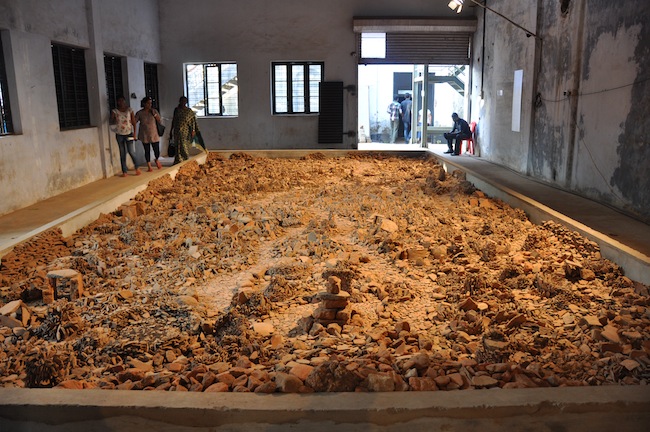
Black Gold by Indian artist Vivan Sundaram
More than 80 artists from 24 countries are participating in the biennial, including the Brazilian star Ernesto Neto, the controversial Chinese artist Ai Weiwei, and the current super-star of Indian art – Subodh Gupta. The central location of the fair is Aspinwall House, a one-time warehouse territory for the harbor, but many works are being shown in venues elsewhere in the city – both in historical buildings or simply outside, in the urban environment.
At first, one may be a bit surprised about the choice of location for the biennial – the burgeoning Indian art scene usually brings to mind such metropolises as Deli and Mumbai, which have seen a real gallery boom in recent years – but Kochi has long been known for its powerful art scene. Kerala distinguishes itself among the other Indian states by having the highest rate of literacy – more than 90% of its inhabitants are educated. Adding to that, 90% of the world's spices are grown here; spices have always been regarded as “gold” in this part of India. The spices were first discovered by the Arabs, then the Romans, Egyptians, Chinese, Portuguese, French and Danes, and only lastly, by the British. Fort Kochi, the old-town part of Kochi, is still a unique mix of Portuguese, Arabian, Dutch, and British architectural styles. Another of Kerala's interesting features is its inland system of connected bodies of water, known as the backwaters, which is made up of 45 rivers and contains 1900 kilometers of interconnected lakes, lagoons and canals. The backwaters were created to facilitate the transport of spices from one town to another, and even today it is still used as an alternative route for transportation. Recently, the backwaters have also become a flourishing part of the tourism industry, offering visitors rides in traditional Kerala boats called houseboats. According to Google, last year Kerala even beat the legendary Taj Mahal in terms of most popular destinations in India.
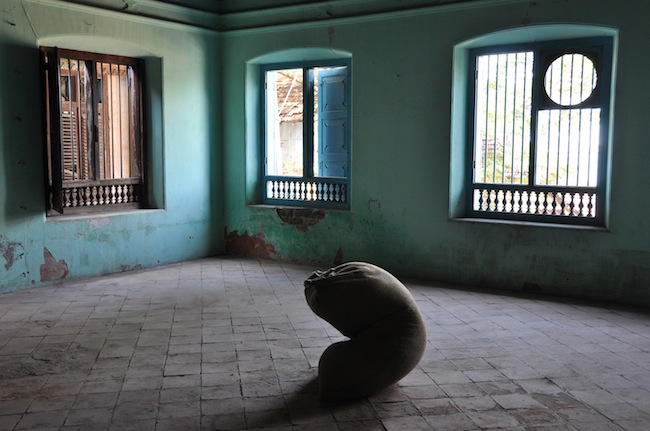
Ernesto Neto
The biennial is the brainchild of two Kerala-born, but now Mumbai-based, artists – Bose Krishmamachari and Riyas Komu. Having started-up two years ago, the ambitious project was swathed in controversy from the start – local artists protested against the initiative brought to their city by relative “outsiders”; in addition, the project was also supported by the Minister of Culture at the time, who was part of the ruling Communist Party. As is par for the course in these types of situations, accusations of corruption, the wasting of funds and other various misdeeds were tacked on to the smear campaign. The planned budget for the biennial was an impressive 730 million rupees, but the inevitable change in government led to a political poker outcome which no longer had “culture” on its list of priorities, and the 730 million became nothing more than a number on a piece of paper. Left without any state support whatsoever, the artists had to manage on their own in terms of finding sponsors – a portion of the biennial's participants even financed their own participation. The current budget is said to be 250 million rupees, of which the lion's share has gone towards restoring the one-time harbor warehouses – outfitting them with the necessary communications technologies and adapting the structures so that they can reasonably present works of art.
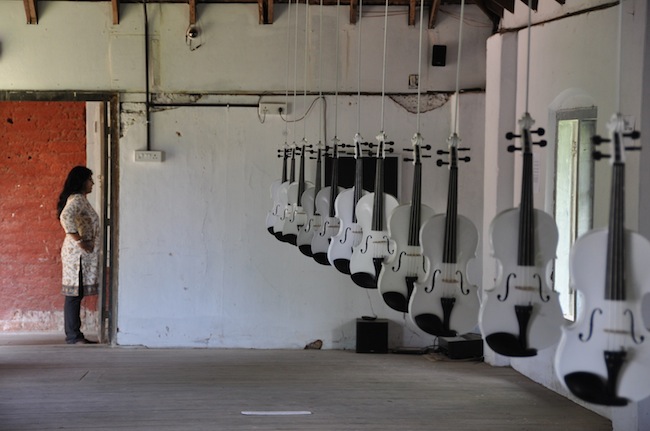
Islamic Violins by Ibrahim Quraishi. A homage to the Fluxus movement
Chris Derkon, director of London's Tate Modern, is giving a lecture at the biennial, and in an interview with the Indian newspaper The Hindu, called the fair the most radical one he's ever seen, staing that “it is a biennial of artists in which the artists themselves have both selected the artists and done the organizational work.” This same feature has also given the event an air of artistic chaos: to make sure that you haven't forgotten that you are in India – where life has a rhythm and order of its own – some of the works were finished only after the biennial's official opening. And of course, some of the works couldn't be seen at certain times due to unforeseen night-time rains.
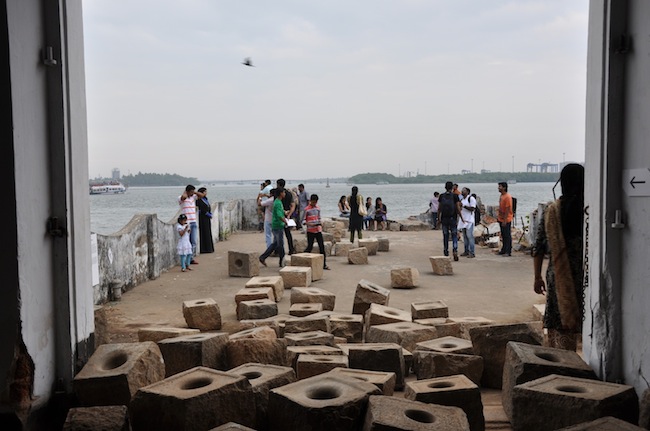
Grinding Stones by Indian artist Sheela Gowda
The chaos, the location, and the fact that most of the works on view were made especially for the biennial and on-site (and from local materials), nevertheless, are exactly the things that give the Kochi Biennale its individuality and authenticity. As The Financial Times so fittingly stated: “...anyone who doubts that artists still work with their hands should have been there on the opening days. It felt like a process-art performance as artists painted, hammered, sewed and conversed urgently with workers, electricians and builders.”
When in Kochi, you feel that art really has taken over the whole city – a portion of the buildings' facades have become a blackboard for street artists. I must also mention that the driver of my impulsively rented tuk-tuk (auto-rickshaw) knew where all of the important biennial spots in the city were to be found – which is much more than can be said of most of his European counterparts (taxi drivers) in their own cities with similar events. It turned out that my driver had already attended the fair on one of its first days (because, after all, it's the first time that anything like this has taken place in the city), when the crowds were so large that he was practically swept off of his feet. Indians are inquisitive, and families swarm around the works of art, carefully studying the accompanying descriptions. It feels a bit like a national celebration, and without a smidgen of the snobbishness or elitism that is usually associated with the contemporary art scene. It would be absurd for something like that to appear here – because how can there be any kind of elitism in the daily chaos of Kochi: among the constantly beeping tuk-tuks, the cows and chickens, the decorations for both the Christian Christmas and Hindi celebrations, the street markets and just the overall, vibrant ruckus of the place? A great number of the biennial's works have been inspired by the surrounding environment, its history, and the current problems it faces, while concurrently serving as a vivid essence of all of the above – a concentrated, emotionally-laden accent for the whole thing. Quite possibly, it is just this aspect – the symbiosis of the varietal environment and the art works – that make India's first biennial so organic and unique. By the way – on the day of the biennial's opening, all schools were closed, and the fair's motto is loud and clear: “This is My Biennale”.
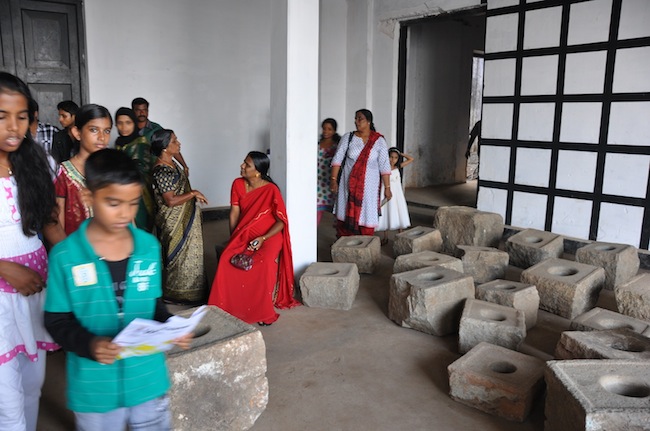
Grinding Stones by Indian artist Sheela Gowda
One of the most poetic pieces in the biennial is the installation Grinding Stones (2012), by Indian artist Sheela Gowda. Half a century ago, every house in Kerala had a special stone for the grinding of spices. In a sense, this stone was the soul of the house – every day, the woman of the house would use a pestle to grind the spices for the day's meals – and so it went, through the years and for numerous generations. The stone block would weigh somewhere around 200 kilograms, and once it was put in place, there it would stay. No one grinds their spices like that in the Indian households of today – now they use electric grinders. But of course, the aroma is not the same anymore. With the rising of real estate prices, many of the old buildings are plundered and then knocked down, and new ones – without any history to them – are erected in their place. Understandably, the old stones don't have a place in these new buildings and – just like cows that no longer give milk and are, thereby, set free to wander the streets – these stones are thrown out somewhere nearby, where they slowly grow over and meld into the environment, and no one takes any notice of them anymore. In her installation, Seela Gowda seeks to activate this old story: in one of the old warehouses she has arranged 170 of these ancient spice-grinding stones – each one marked with its own ravages of time – in a symbolic road that winds through the warehouse's large doors and outside, in the direction of the canal – the one-time vein of the spice trade. Today, the canal carries barges and small motorboats with tourists. Indian women, dressed in saris, enter the space and tend to sit down on the stones to chat with their companions, just like they would by a hearth; meanwhile, their husbands weave their way among the stones as they go outside and head towards the canal to look at the boats.
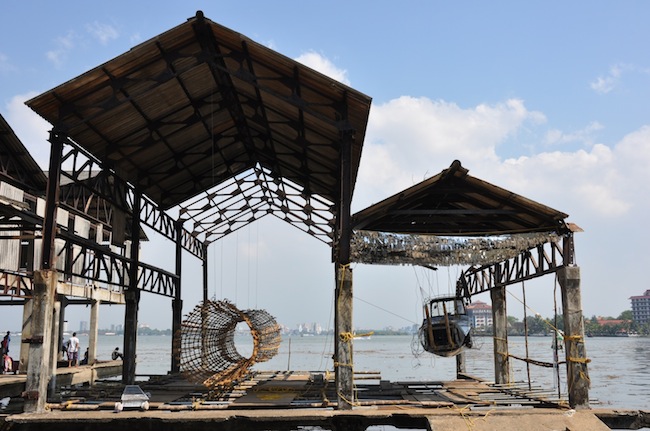
On a side note, a similar fate stands in store for some of the sites currently used by the biennial – one of the old warehouses is slated to be transformed into a luxury hotel, and there are plans for reconstruction in the territory of the harbor. This fact makes the biennial a last-chance opportunity to experience the Kochi that will soon disappear from the pressures of global tourism and the side-effects of urbanization. The century-old wooden stairs, heavy doors and wide-planked wooden floors of Kochi will, most likely, be swept away. Adding to this existentialistic tone is the piece Untitled (2012), by Indian art super-star Subodh Gupta. It is a huge wooden boat that has been propped up on one end and stuffed full of domestic objects found nearby: milk cans, pots, a broken TV, a fan, chairs, table legs, etc. The boat as a microcosm, containing the belongings of a refugee; not as a method of transportation, but rather as salvation and a place for one to live. The reason for fleeing – be it migration, political motives, an environmental catastrophe – is irrelevant. “A handful of earth or a piece of clay are often all that a person can hold on to when the whims of nature whisk him away,” the artist declares in his description of the piece. Each of the items that have been thrown into the boat are like a ghost story – a story about dashed dreams and illusions, and about the bare-naked goal of survival.
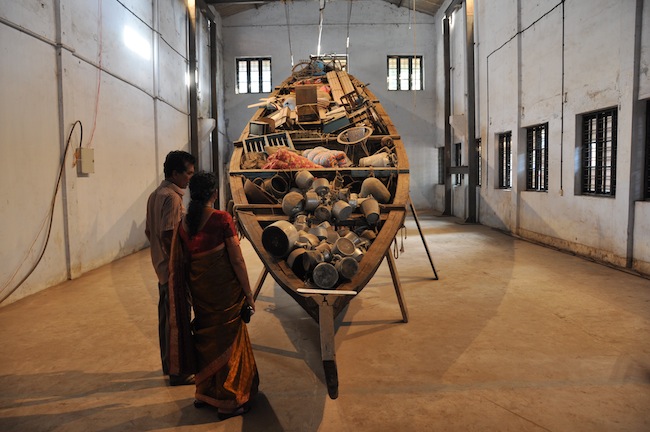
Untitled by Indian artist Subodh Gupta
In the small building that houses the video works of controversial Chinese artist Ai Weiwei, both rooms are blackened with soot. Directly across from the screen sits a wooden bench and a fan – existential asceticism in Kochi's sweltering heat. Two works by Ai Weiwei can be seen at the biennial; one of them, titled “So Sorry”, was made shortly after the artist's exhibition in Munich, which had itself served as yet another irritant in his already-strained relationship with the Chinese government.

Video work by Chinese artist Ai Weiwei
The installation Life Is a River (2012), by Brazilian artist Ernesto Neto, has been exhibited in the attic of a 400-year-old building which was once a coconut-fiber processing factory. To see the piece, one must climb up a dusty wooden ladder and through a hatch that leads up to the attic; optimally, without banging your head along the way. The air is so thick and heavy in this attic overheated by the sun that you can almost stir it like a dish of curry; which, as it happens to be, is what lies inside Neto's famous “bags of spices”. The orange fabric that makes up the lycra “socks” stuffed full of spices – which look a little bit like swollen cow udders – was found by the artist right there in Kachi's local marketplace. Through the cracks in the ceiling beams, one can just make out the river. Neto's piece in the biennial is a scented variation of his “monsters”, which began their marathon of popularity at 2001's Venice Biennale; there they had gained the status of “must-see objects”. The year before last, a related large-format installation by Neto could be seen at Rome's museum of contemporary art, Macro. If the piece at Macro was considered intriguing and slightly exotic – a gigantic “jellyfish” of spices that shocked not only with its size, shape and refined tonalities of color, but also, as one stands there in the ascetic white cube, with its marked effect on the sense of smell, – then in the attic in Kochi, one has the feeling that the piece is in its true place – at home. And it fits in so organically that one could almost believe that curry has always been kept in socks. It's a brutal, untamed kind of beauty.
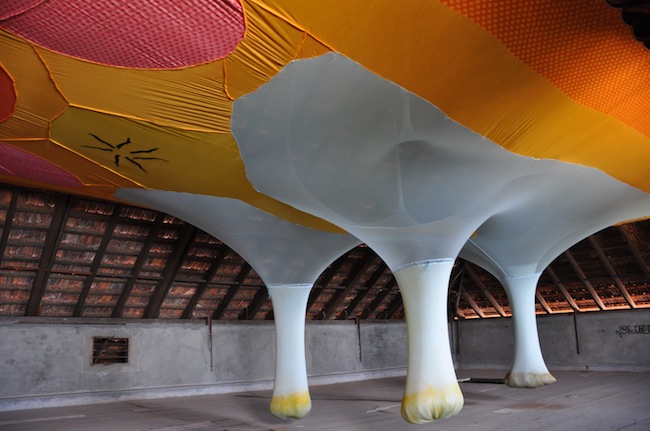
Life Is a River by Brazilian artist Ernesto Neto
Although I must admit that the overall quality of art works at the biennial seems to be, at times, just as irregular as daily life in India, this character of robust “realness” just may be its greatest asset. The roughness of both the environment and the obvious handwork at play, as well as the utter lack of “big money” sniffing about, make it a healthy alternative to the current scene going on in the Western art market. The next Kochi-Muziris Biennale is scheduled for 2014.
The Kochi-Muziris Biennale in the Kerala State city of Kochi, India, continues until March 13, 2013.